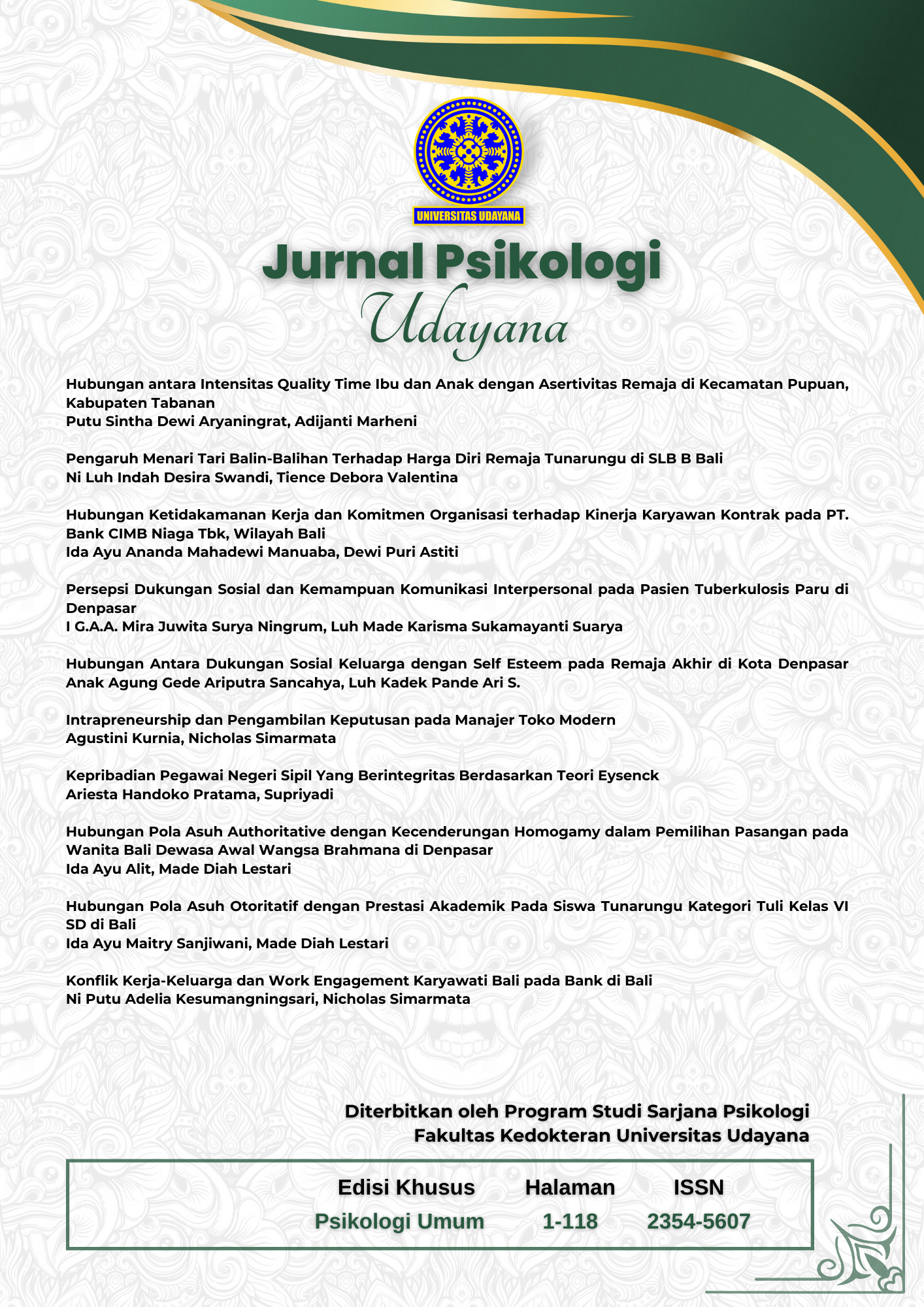HUBUNGAN ANTARA INTENSITAS QUALITY TIME IBU DAN ANAK DENGAN ASERTIVITAS REMAJA DI KECAMATAN PUPUAN, KABUPATEN TABANAN
Abstract
Adolescence is part in life where human change from childhood into adult (Olds, 2009). In their daily life, adolescents spend their more time with their peers (Papalia et al, 2008). An adolescent with working parent, especially adolescents in Pupuan that majorly have parents who work as a farmer, exactly have a lower intensity of time with their parent. The lower time that adolescents spend with their mother, will make a negative effects to adolescent’s cognitive development (Boca, 2012). Mother who work, will influence there adolescent. So, the researcher would like to know are there any significant relationship between the intensity of quality time among the mother and child with the adolescence assertiveness?
This research used quantitative method with simple linear regression for data analysis. Researcher collected data by 2 questionnaires (intensity of quality time scale and assertiveness scale) with the reliability of 0,897 and 0,900 from 240 adolescents that take by stratified random sampling with the criterions such as adolescents with age range between 13-15 years old, live in Pupuan, and have a mother who works as farmer.
This research found that there is a relationship between the intensity of quality time among the mother and child with the adolescence assertiveness with the correlation’s coefisien 0,395. There are 15,6% assertiveness is influence by the intensity of quality time among mother and child and 84,4% is influence by the other factors. For the deepen explanation, I used adolescence’s socioemotional theories from Papalia (2008).
Key words: Quality time intensity, Assertiveness, Adolescence
Downloads
References
Ayuni, Q. (2010). Perbedaan tingkat asertivitas antara siswa dari keluarga lengkap dengan siswa dari keluarga single parent di smk negeri 1 pakong, pamekasan madura. Malang: UIN Malang.
Azwar, S. (2010).Dasar-dasar psikometri. Yogyakarta: pustaka Pelajar.
Azwar, S. (2010).Reliabilitas dan validitas. Yogyakarta: Pustaka Pelajar.
Bartlett, J. E, Kotrlik, J. W, Higgins, C. C. (2001). Organizational research: Determining appropriate sample size in survey research. Information Technology, Learning, and Performance Journal,19,43-50.
Boeree, C. (2006).Personality theories. Yogyakarta: Primasophie.
Bornstein, M. H. (2002). Practical issues in parenting. New Jersey: Lawrence Erlbaum Associates Publisher.
Cangara, H. (2006). Pengantar ilmu komunikasi. Jakarta: PT. Raja Grafindo Persada
Cossa, M. (2006). Rebels with causes: Working with adolescents using action techniques. London: Jessica Kingsley Publisher.
Daniela Del Boca, C. M. (2012). Children's and parents time-use choice and cognitive development during adolescence . Chicago: Human Capital & Economic Opportunity Working Group Center.
Desmita.(2005). Psikologi perkembangan. Bandung: Rosda Karya.
De Vito, Joseph A. (1997). Komunikasi antarmanusia edisi kelima. Jakarta: Professional Books
Diane E. Papalia, S. W. (2008). Human Development (Psikologi Perkembangan) 9th Edition. Jakarta: Kencana.
Emmons, M. (2002).Your perfect right, hidup lebih bahagia dengan menggunakan hak. Jakarta: Komputindo.
F. Philip Rice, K. G. (2002). The adolescent (development, relationships, and culture) 10th edition. Boston: A Pearson Education Company.
Fitiyana, F. (2009).Perbedaan tingkat asertivitas siswa kelas akselerasi dengan siswa kelas reguler.Skripsi. Malang: Program S1 UIN Malang. Dipetik tanggal 4 November 2012, dari http://lib.uin-malang.ac.id/?mod=th_detail&id=05410078.
Fiftina, A. F. (2011). Hubungan kepercayaan diri dengan perilaku asertif pada siswa sma korban bullying. Jakarta: Universitas Gunadarma. Dipetik 15 Februari 2013, dari http://repository.gunadarma.ac.id/bitstream/123456789/1240/1/10507299.pdf
Husetiya, Y. (2010). Hubungan asertivitas dengan prokrastinasi akademik pada mahasiswa fakultas psikologi universitas diponegoro semarang. Semarang: Fakultas Psikologi Universitas Diponegoro. Dipetik 4 November 2012, dari http://eprints.undip.ac.id/24780/1/jurnal1_mima.pdf
James White, E. H. (2011). Family meal frequency and alcohol and tobacco use in adolescence: Testing reciprocal effects. The Journal of Early Adolescence, 31 (5), 735-749.
Laura M. Padilla-Walker, J. M. (2011). Pathways to parental knowledge: The role of family process & family structure. The Jornal of Early Adolescence, 31 (4), 604-627.
Marchena, P.E. (2004). Quality time in dual earner families.The Emory Center for Myth and Ritual in American Life. Dipetik 28 Agustus 2012, dari http://www.marial.emory.edu/pdfs/Marchena-WorkingPaper37.pdf.
Marini, Liza dan Andriani, Elvi .(2005). Perbedaan asertivitas remaja ditinjau dari pola asuh orang tua. Psikologia, 1 (2), 46-51.
Martono, N. (2010). Metode penelitian kuantitatif (analisis isi dan analisis data sekunder). Jakarta: PT.Raja Grafindo Persada.
Noelly M.Hurd, M. A. (2011). Role model behavior and youth violence: A study of possitive and negative effects. The Journal of Early Adolescence, 31 (2), 323-331.
Nurgiyantoro, B., Gunawan, Marzuki. (2009). Statistik terapan untuk penelitian ilmu-ilmu sosial. Yogyakarta: Gadjah Mada University Press.
Oktaviana, R. (2004). Hubungan antara penerimaan diri terhadap ciri-ciri perkembangan sekunder dengan konsep diri pada remaja putri sltpn 10 yogyakarta. Jurnal Psyche, 1 (2), 1-11.
Pipas, Maria Daienal. (2010). Assertive communication skills.Annales Univertatis Apulensis Series Oeconomica. Dipetik 12 Agustus 2012, dari http://www.oeconomica.uab.ro/upload/lucrari/1220102/17.pdf.
Porpitasari, M. D. (2007). Pengaruh kemampuan asertif terhadap hubungan interpersonal.Skripsi. Malang: S1 UIN Malang. Dipetik 4 Novvember 2012, dari http://lib.uin-malang.ac.id/?mod=th_detail&id=03410054.
Price, J. (2008). Parent-child quality time (does birth order matter?). Journal of Human Resources, 43 (1), 240-265.
Prof.Rozaini Nasution, S. (2003). Teknik sampling. Medan: USU Digital Library.
Rini, J. (2001). Asertivitas. Dipetik 28 Agustus 2012, dari http://www.e-psikologi.com/epsi/individual_detail.asp?id=109
Santoso, Singgih (2003). Mengatasi berbagai masalah statistik dengn spss versi 11.5.Jakarta : PT. Elex Media Komputindo
Sanusi, S. R. (2005). Beberapa uji validitas dan reliabilitas pada instrumen penelitian. Medan: USU Digital Library.
Setiawan, N. (2005). Pengolahan dan analisis data. Bogor: Departemen Pendidikan Nasional Inspektorat Jenderal.
Simperingham, G. (2010, Februari 9).Quality one on one time with your child. Dipetik 12 Agustus 2012, dari Peaceful Parents Institute: http://www.peaceful-parent.com/article_quality_time_child.php
Sugiyono, Prof.DR. (2012). Statistika untuk penelitian. Bandung: Penerbit Alfabeta
Suryabrata, S. (2000).Metodologi penelitian. Jakarta: PT Raja Gafindo Persada .
Anom.(2010, Agustus 24).Profil kecamatan pupuan.Dipetik 10 Agustus 2012, dari Pemerintah Kabupaten Tabanan: http://www.tabanankab.go.id/profil-kecamatan/kecamatan-pupuan
Wardani, E. H. (2009). Belenggu-belenggu patriarki: Sebuah pemikiran feminisme psikoanalisis toni morrison dalam the bluest eye. Fakultas Ilmu Budaya Undip.
Widjaya.(2000). Ilmu komunikasi pengantar studi. Jakarta: Rineka Cipta.
Williams, D. C. (2000).Being assertive. UK: Arnold Publisher University of Glasgow
Authors who publish with this journal agree to the following terms:
- Authors retain copyright and grant the journal right of first publication with the work simultaneously licensed under a Creative Commons Attribution-ShareAlike 4.0 International License that allows others to share the work with an acknowledgement of the works authorship and initial publication in this journal.
- Authors are able to enter into separate, additional contractual arrangements for the non-exclusive distribution of the journals published version of the work (e.g., post it to an institutional repository or publish it in a book), with an acknowledgement of its initial publication in this journal.
- Authors are permitted and encouraged to post their work online (e.g., in institutional repositories or on their website) prior to and during the submission process, as it can lead to productive exchanges, as well as earlier and greater citation of published work (See The Effect of Open Access).













